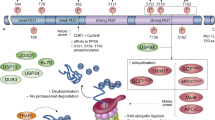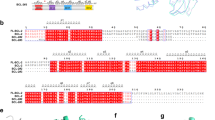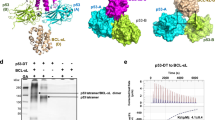Abstract
Bcl-2 is the prototype of a class of oncogenes which regulates apoptosis. Bcl-2-related gene products with either death-promoting and death-inhibitory activity are critically involved in numerous disease states and thus constitute prime targets for therapeutic interventions. The relative amount of death agonists and antagonists from the Bcl-2 family constitutes a regulatory rheostat whose function is determined, at least in part, by selective protein-protein interactions. Bcl-2 and its homologs insert into intracellular membranes including mitochondria, the endoplasmatic reticulum and the nuclear envelope. Many of the molecular genetic, ultrastructural, crystallographic and functional studies suggest that Bcl-2-related molecules exert their apoptosis-regulatory effects via regulating mitochondrial alterations preceding the activation of apoptogenic proteases and nucleases. Via a direct effect on mitochondrial membranes, Bcl-2 prevents all hallmarks of the early stage of apoptosis including disruption of the inner mitochondrial transmembrane potential and the release of apoptogenic protease activators from mitochondria. The mitochondrial permeability transition (PT) pore, also called mitochondrial megachannel or multiple conductance channel, is a multiprotein complex formed at the contact site between the mitochondrial inner and outer membranes, exactly at the same localization at which Bax, Bcl-2, and Bcl-XL are particularly abundant. The PT pore participates in the regulation of matrix Ca2+, pH, ΔΨm, and volume and functions as a Ca2+-, voltage-, pH-, and redox-gated channel with several levels of conductance and little if any ion selectivity. Experiments involving the purified PT pore complex indicate that Bax, Bcl-2, and Bcl-XL exert at least part of their apoptosis-regulatory function by facilitating (Bax) or inhibiting (Bcl-2, Bcl-XL) PT pore opening. These findings clarify the principal (but not exclusive) mechanism of Bcl-2-mediated cytoprotection.
This is a preview of subscription content, access via your institution
Access options
Subscribe to this journal
Receive 50 print issues and online access
$259.00 per year
only $5.18 per issue
Buy this article
- Purchase on Springer Link
- Instant access to full article PDF
Prices may be subject to local taxes which are calculated during checkout
Similar content being viewed by others
Author information
Authors and Affiliations
Rights and permissions
About this article
Cite this article
Zamzami, N., Brenner, C., Marzo, I. et al. Subcellular and submitochondrial mode of action of Bcl-2-like oncoproteins. Oncogene 16, 2265–2282 (1998). https://doi.org/10.1038/sj.onc.1201989
Received:
Revised:
Accepted:
Published:
Issue Date:
DOI: https://doi.org/10.1038/sj.onc.1201989
Keywords
This article is cited by
-
Bioinformatic identification and expression analysis of the chicken B cell lymphoma (BCL) gene
Genes & Genomics (2019)
-
The apoptotic inducible effects of salicylic acid on hepatoma cell line: relationship with nitric oxide signaling
Journal of Cell Communication and Signaling (2017)
-
Activation of the JNK-c-Jun pathway in response to irradiation facilitates Fas ligand secretion in hepatoma cells and increases hepatocyte injury
Journal of Experimental & Clinical Cancer Research (2016)
-
RETRACTED ARTICLE: Bufalin Exerts Inhibitory Effects on IL-1β-Mediated Proliferation and Induces Apoptosis in Human Rheumatoid Arthritis Fibroblast-Like Synoviocytes
Inflammation (2014)
-
C-peptide reduces high-glucose-induced apoptosis of endothelial cells and decreases NAD(P)H-oxidase reactive oxygen species generation in human aortic endothelial cells
Diabetologia (2011)



